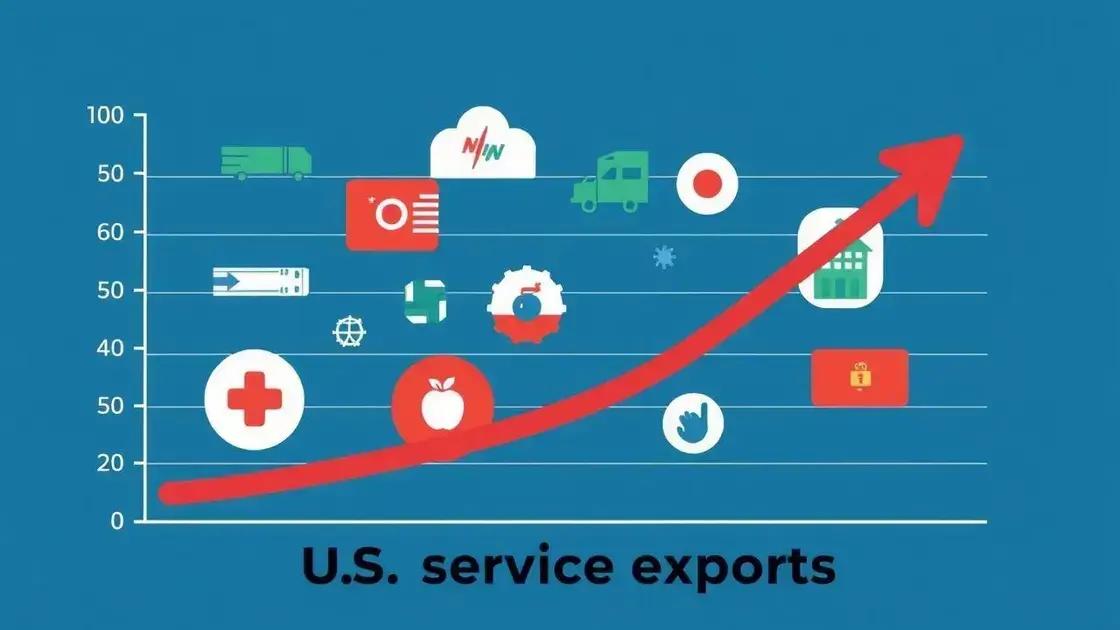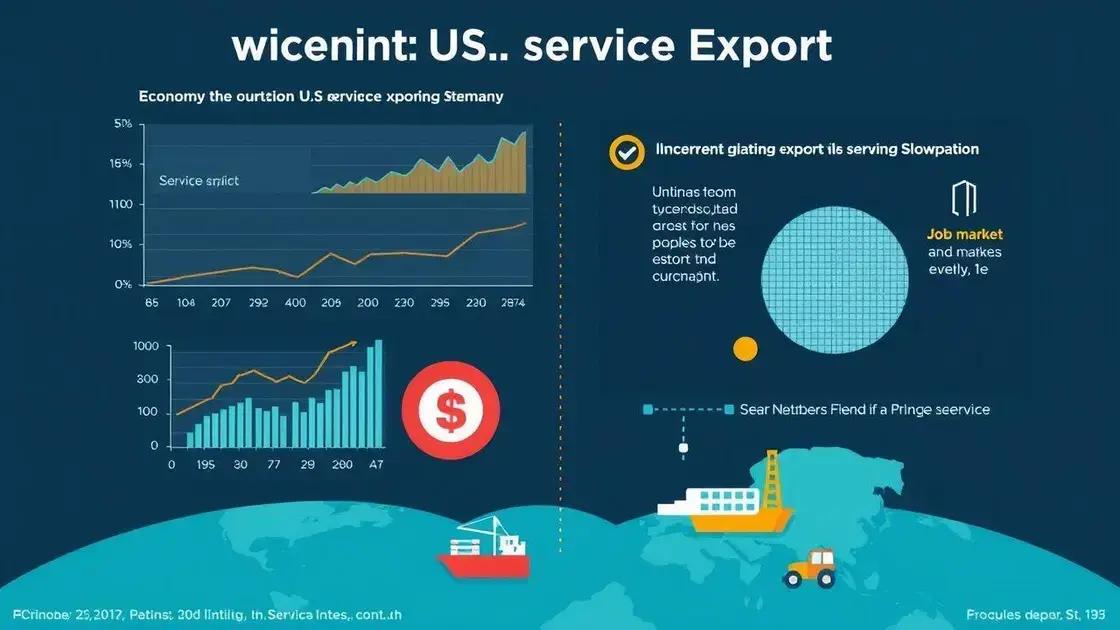Significant deceleration in U.S. service exports: what it means

Significant deceleration in U.S. service exports is primarily driven by global economic conditions, consumer behavior shifts, and regulatory changes, impacting sectors like technology, travel, and finance.
Significant deceleration in U.S. service exports is sparking debates among economists and industry experts alike. What does this slowdown mean for the economy and the global market?
Understanding the current state of U.S. service exports
Understanding the current state of U.S. service exports is crucial in evaluating economic trends. Recently, there has been a noticeable decline, which raises questions about the underlying causes. As we delve into this topic, it’s important to consider how different sectors are impacted.
Current Statistics
Recent reports show a significant decrease in service exports. The data indicates that the total value has dropped by approximately 10% over the past year. Understanding these statistics helps in grasping the severity of the situation.
Why the Decline?
Several factors contribute to this downturn. The primary reasons include:
- Global Economic Slowdown: The overall global market is facing a challenging phase, affecting demand for U.S. services.
- Increased Competition: Other nations are elevating their service offerings, making it harder for U.S. providers to maintain their market share.
- Travel Restrictions: Ongoing travel restrictions due to health concerns continue to impact sectors like tourism and hospitality.
Moreover, the shift towards remote work has altered how companies view international service engagements. Many companies now rely heavily on local contractors instead of overseas services, further impacting export numbers.
Sector-specific analysis reveals that industries such as technology and finance have also felt the pinch. These sectors, traditionally strong in exports, now face challenges in engaging foreign markets effectively. The reduction in business travel, for example, has severely impacted these services.
Broader Implications
The deceleration in U.S. service exports does not just reflect market dynamics but also indicates potential long-term economic impacts. If this trend continues, it could lead to job losses in sectors reliant on international business.
Thus, it’s vital for policy makers and business leaders to monitor these changes closely. Adapting strategies to reclaim lost markets and fostering innovation will be key to reversing this trend. The future of U.S. service exports depends on how effectively these challenges are addressed.
Key factors driving the slowdown
Several key factors are driving the slowdown in U.S. service exports. Understanding these elements is essential because they help explain how external and internal dynamics affect the economy. Let’s explore them in detail.
Global Economic Conditions
The current global economic climate plays a significant role. Economic downturns in various countries can decrease demand for exported services. When economies struggle, businesses often cut back on spending, including outsourcing services.
Shifts in Consumer Behavior
Changing consumer preferences also impact service exports. With technology, many consumers now prefer local or digital solutions over international services. This shift reduces the attractiveness of U.S. service providers.
Regulatory Changes
Increased regulations can further complicate international trade. New barriers can make it harder for U.S. companies to compete in foreign markets. This includes tariffs or restrictions that affect service delivery.
- Trade Policies: Policies that are unfavorable to exporting can limit opportunities.
- Compliance Costs: Navigating new regulations can lead to higher operational costs.
- Intellectual Property Concerns: Companies may hesitate to enter markets where their intellectual property isn’t protected.
Additionally, ongoing challenges like supply chain disruptions have a ripple effect. If products can’t be delivered on time, service providers who depend on these goods will find it challenging to maintain their operations internationally. Each disruption can lead to a decrease in service reliability.
Technological advancements also shift the landscape. While technology can enhance service delivery, it also opens the door for competition. New entrants, often leveraging innovative tools, can disrupt established businesses, leading to a decline in U.S. exports.
Lastly, the impacts of global events, such as pandemics, profoundly affect service industries. Travel restrictions limit face-to-face interactions, resulting in lost contracts and reduced collaboration opportunities. All these factors combined create a complex environment for service exports.
Impact on the U.S. economy and global trade

The impact of the slowdown in U.S. service exports is significant, affecting both the domestic economy and global trade dynamics. This decline not only disrupts local businesses but also resonates in worldwide markets.
Effects on Domestic Economy
As service exports decline, U.S. businesses that heavily rely on international clients face challenges. Reduced revenues can lead to job cuts and lower investments in growth. Companies that once thrived on overseas contracts may find it challenging to sustain their operations.
- Increased Unemployment: As businesses cut costs, job losses may follow, impacting communities.
- Reduced Wages: Employers may lower wages or freeze pay raises due to decreased income.
- Investment Decline: Companies may delay or cancel plans for expansion, slowing economic growth.
Furthermore, states and local governments that depended on tax revenues from these services may face budgetary pressures. Less revenue means fewer resources for public services, impacting education, infrastructure, and community programs.
Global Trade Dynamics
The drop in U.S. service exports also alters global trade relationships. As U.S. companies struggle, competitors in other countries may seize the opportunity to expand their market share. This shift may lead to a more significant presence of foreign service providers in areas previously dominated by U.S. firms.
This competitive shift can lead to a restructuring of global trade, redefining how services are exchanged between countries. Countries that once depended heavily on U.S. services may start to rely more on local or regional providers, changing the landscape of international commerce.
The overall decline in service exports can represent a shift in geopolitical power as well. Nations that can adapt quickly and innovate in service delivery might gain a competitive edge in the global market. This new dynamic creates challenges for the U.S. as it seeks to maintain its leadership role in the world economy.
In conclusion, understanding these impacts is crucial for policymakers and business leaders. Addressing the slowdown in service exports proactively can help mitigate adverse effects and recover lost ground in both local and global economies.
Sectoral analysis: which services are affected?
A sectoral analysis reveals that various services are affected by the significant deceleration in U.S. service exports. Understanding which sectors are struggling helps in addressing the challenges they face.
Technology Services
The technology sector has seen a reduction in demand for software development and IT services from international clients. Many global companies are now opting for local talent, reducing their reliance on U.S. firms. This shift is largely due to cost considerations and a desire for quicker service delivery.
Travel and Hospitality
The travel and hospitality industry has also been hit hard. Restrictions on international travel have made it difficult for hospitality services to attract foreign visitors. Hotels, airlines, and tour operators report significant declines in bookings, leading to substantial revenue losses.
- Airlines: Experienced a dramatic fall in international passengers.
- Hotels: Many face low occupancy rates due to less travel.
- Tourism Services: Local attractions struggle without foreign tourists.
This sector’s recovery is slow, as many travelers remain hesitant to venture abroad due to ongoing health concerns.
Financial Services
Financial services, including banking and insurance, are also facing challenges. Many international clients are reducing their transactions with U.S. firms, seeking localized services instead. Compliance with new regulations has increased the operational costs for U.S. financial firms, affecting their competitive edge.
Educational services, such as international student enrollment in U.S. universities, have further declined. Students are either choosing local institutions or online alternatives, leading to fewer international students in the U.S.
Each service sector is uniquely affected by this slowdown. Understanding their struggles can help businesses adapt and innovate to regain their international market share. Collaboration between these sectors and policymakers may also address the root causes of the decline.
Future outlook and potential recovery strategies
The future outlook for U.S. service exports hinges on several factors, and recovery strategies are essential for addressing the current slowdown. Businesses must adapt to the evolving market to regain their competitive edge.
Market Recovery Potential
While the current situation seems challenging, opportunities for recovery exist. Analysts suggest that as global conditions improve, demand for U.S. services may rise again. Economic rebounds in key markets can lead to renewed interest in American services.
Focus on Innovation
Innovation plays a crucial role in the recovery process. Companies need to embrace technological advancements to enhance their service offerings. This could mean investing in:
- Digital Transformation: Developing online platforms can meet customer needs more efficiently.
- Automated Solutions: Using automation to streamline processes can reduce costs and improve service delivery.
- Data Analytics: Leveraging data can help businesses understand market trends and customer preferences.
Furthermore, enhancing customer experience is vital for attracting and retaining clients. U.S. companies should focus on personalized services to stand out in a competitive global market.
Diversifying Markets
Diversifying markets can also aid recovery. By expanding into emerging economies, U.S. service providers can tap into new customer bases. This strategy reduces dependency on any single region and spreads risk.
Additionally, building strategic partnerships with local firms can facilitate market entry. Collaborations can provide valuable insights and resources, making it easier to navigate foreign markets.
Policy Support
Government policies will play a pivotal role in the recovery of the service export sector. Trade agreements that lower tariffs and barriers can boost demand for U.S. exports. Supportive measures, such as grants for businesses entering new markets, can encourage growth.
Ultimately, a combined effort from businesses and policymakers is crucial for recovery. Emphasizing innovation, market diversification, and supportive policies can position U.S. service exports for a stronger future.
\n
| 🌟 Key Points | 💡 Insights |
|---|---|
| Focus on Innovation | Embrace technology for service improvement. |
| Market Diversification | Expand into emerging markets to reduce risks. |
| Collaborate with Policymakers | Work together for supportive trade policies. |
| Address Consumer Needs | Personalize services to enhance customer experience. |
| Focus on Growth | Adapt and innovate for a brighter future. |
\n
\n
FAQ – Frequently Asked Questions about the Significant Deceleration in U.S. Service Exports
What are the main factors contributing to the slowdown in U.S. service exports?
Key factors include global economic conditions, shifts in consumer behavior, and regulatory changes that impact international trade.
Which sectors are most affected by the decline in service exports?
Sectors like technology, travel and hospitality, and financial services have been significantly impacted due to decreased demand and competition.
What strategies can businesses adopt to recover from the slowdown?
Businesses can focus on innovation, diversify markets, embrace technology, and collaborate with policymakers to create supportive trade environments.
How does the slowdown in service exports affect the U.S. economy?
It can lead to job losses, reduced wages, and decreased investment, which ultimately affect overall economic growth and community resources.






